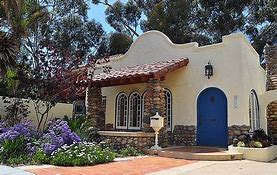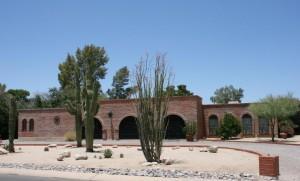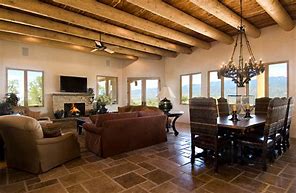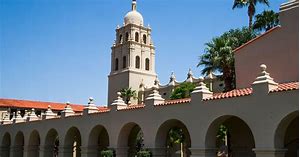Pueblo Indian Influence in Southwest Architecture
Tucson And Southern Arizona Are A Showplace For Pueblo Revival Architecture.

The Pueblo Indians of the southwest weren’t the only influence on this type of architecture, but they were extremely important.
The Pueblo style was in interwoven with the Spanish who crossed the Atlantic and fell in love the region.
One common addition to the Pueblo design that shows the Spanish influence is the prevalence of iron doors.
Similar architecture can be found across a vast portion of the US Southwest and down into Northern Mexico.
Pueblo Revival architecture began in the early 1900s, becoming a popular trend throughout the 1920s and 1930s. Here is a brief description of some evident characteristics of this southwestern style of architecture, plus some beautiful buildings you can visit to see it firsthand.
Key Aspects of Southwest Architecture
The Pueblo Revival style of architecture is a gentle blend of the indigenous peoples of the region and their Spanish ancestors. You can explore examples of both influences combined in these buildings.
Once you understand the concepts of the Pueblo Revival architectural style, you can begin to appreciate which homes have it, or how you could add it to yours. Here’s a quick list of design features that are readily seen in this type of architecture.
Adobe –

Even today, homes built with thick red clay bricks are prevalent throughout the southwest.
They also made direct use of different aspects of this brick-like material for cooking and water storage. Newer Arizona homes built to resemble the style use a stucco finish made to replicate adobe.
In modern-designs, thick walls are made to resemble the actual adobe built by the Pueblo Indians. Earth tones blend into the surround landscape colors, therefore these are the most common colors of homes and buildings using this style.
Wood Support –

Many of the original Pueblo homes show evidence of this design feature. The beams stick through the walls and are visible from outside the home. It is not uncommon to see crude wooden ladders adjacent to a home.
During the latter part of the 12th century, a period when the Puebloan population increased in the area, they built multistory dwellings into the cliffs. To gain access to various levels; instead of staircases they simply used wooden ladders.
Flat Roofs –
Flat Roofs – While the exterior design of Pueblo Revival architecture predominately uses rounded corners, the roofs are flat. The flat roof tops may have a very slight slant to them and have an outside wall extending above the roof line.
These extensions were called parapets. Drainage openings were cut above the roof line. There is no indication of the actual reason for this unique wall design, other than possibly protection from enemies.
Pueblo Revival Style in Arizona

Numerous buildings on the campus reflect an obvious blend of both the Puebloan and Spanish influences on architecture in Arizona. The magnificent Brophy College Chapel is on the National Register of Historic Places.
There are a number of architectural styles thought historic districts in both Phoenix and Tucson. Another enjoyable option for both entertainment as an example of Pueblo Revival architecture is the Painted Desert Inn.
Originally built as part of the Civilian Conservative Corps construction projects of the Great Depression, the Inn was finished in the late 1930s. The complex is located adjacent to Petrified Forest National Park in eastern Arizona.
On the southern edge of the Grand Canyon in Arizona is the famous Hopi House. The Hopi House is one of eight architectural masterpieces designed by world-renowned architect Mary Colter.
The building’s style is a reflection of the traditional Hopi Pueblo multilevel dwellings. Hopi House was completed in 1904 and is a perfect example of the lifestyle of the native inhabitants of the US Southwest.
Still Used Today
The Pueblo Revival style of architecture is still used today. Home builders and architects appreciate the perfect blend of the ancestral Pueblo design into the adjoining Arizona landscape.
Many of the finest homes in and around Arizona’s two largest cities have large courtyards. Tucson is #2, you can guess what city is the largest.
These outdoor areas were inherent to even the oldest native homes. The weather is hot, but the ability to be outside is a welcome opportunity that is year-round in Arizona.
These are examples of the architectural style engendered to southwestern culture. If you’re looking to purchase a home in Arizona, or remodel an existing home, visit any of these marvelous examples of Pueblo Revival architecture.
Guest Article by Jessica Kane
Considering A Home In Tucson, AZ?
Are you thinking of buying a home in the greater Tucson area? Finding the right home can be a challenging process. But we can make the process much less stressful for you.
We have been Tucson Realtors since 2002. We know Tucson and the Tucson Real Estate market. As a top Realtor duo, we invest the time to understand your home buying interests and desires.
At our first meeting, we will review the current real estate market with you. Show you the market data and then walk you through the Arizona home buying process.
Why? We want you to know what to expect. And what to plan for.
Interested in new construction? We’ll brief you on buying a new construction home. And what’s unique about the process.
For us, you are not another real estate transaction. You are a client and, future friend. We strive to create a relationship that continues long after you move into your home. Review our profiles. Check out our backgrounds, education, and certifications.
We are here to help you “know what you need to know” to buy a home in Tucson, AZ. We provide you information on Tucson events, places to shop and restaurants.
Our resources include contractors, electricians, and home services.
And best of all our professional service backgrounds mean we put you first!
Conclusion
Thank you for visiting www.premiertucsonhomes.com! It’s one of the top real estate websites in Tucson. Our clients tell us that.
Our website provides information on communities and neighborhoods in the greater Tucson area. Want more? Give us a call – 520-940-4541.
We are ready to answer your questions and help you get the information you are looking for.
We are a top Realtor team in Tucson, AZ since 2002. Take a few minutes to read our profiles and client testimonials.
Are we the Tucson Realtors you have been looking for?
Sign UP to receive daily HOME TRACKER UPDATES - OR - Our Monthly NEWSLETTER. And get regular updates on the Real Estate Market and events in Tucson, AZ.
Questions about the Tucson Real Estate Market or Tucson Homes for Sale? Call Us - 520 940 4541 OR complete the - CONTACT FORM - and we will get right back to you!
BACK to the ABOUT TUCSON page.
